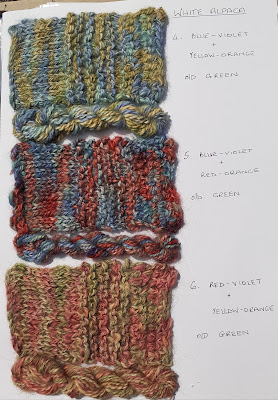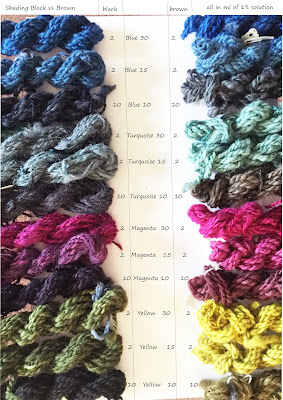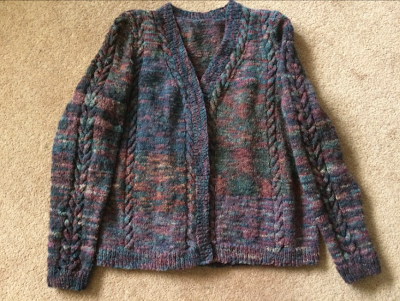Edda and Stephanie Experimented with Dyes
By Stephanie
Before Covid restrictions our group have enjoyed an annual summer's day in a member's garden (latterly Jane's), spinning, knitting, chatting and, most importantly, dyeing. Various acid and natural dyes were available to dabble with on each occasion.
This inspired Edda and I to have a bit of fun trying the effects of different recipes, using controlled dye solutions. For the two experiments below, we used acid dyes from DT Crafts.
On one occasion, we experimented with 1% solutions of acid dyes to investigate the effects of the addition of brown versus black on the shading of colours.
Four basic colours (blue, magenta, yellow and turquoise) were mixed with either brown or black in the following proportions:
These were added to 10g skeins of wool yarn, which were wrapped in clingfilm and microwaved for 2-3 minutes.
Lovely shades were obtained. Brown, as expected, gave softer, more subtle shades than black, as can be seen in the photo.
We were also fascinated by an article on Overdyeing by Elaine Watkins in the Ashford magazine, so we decided to have a go.
This time we used batches of 200g of soaked white Jacob fleece, white alpaca and apricot-grey alpaca. Each of these was placed in an M shape in a pan of water to which 1 tsp white vinegar had been added. The top of the water was just below the top of the skein.
As the article suggested, we used tertiary colours (0.5tsp of each of two colours made up to 100ml), overdyed with a secondary colour (1tsp to 100ml water). So, for example, we poured a mixture of blue-violet across the top of the M-shaped skein and yellow-orange across the bottom. When the water cleared after simmering, the yarn was removed. Sufficient water was then added to the pot to ensure that the skein would be covered and green dye (1tsp to 100ml water) was added. The whole skein was immersed and simmered until the dye had been used up.
Needless to say, we got carried away and similarly tried other colour combinations, as shown in the chart below, and some lovely effects were obtained.
The subtle colours obtained with white and apricot-grey alpaca are shown below.
 |
| White alpaca dyed with combinations 4, 5 and 6 |
 |
| Apricot-grey alpaca dyed with combinations 4, 5 and 6 |
White Jacob fleece gave much denser, brighter colours, as can be seen below. The arrows point to skeins 4, 5 and 6, which compare directly with the alpaca shown above.
Finally, I actually used the apricot-grey alpaca with the formula of red-orange and blue-green, overdyed with violet to create a cosy cardigan.






